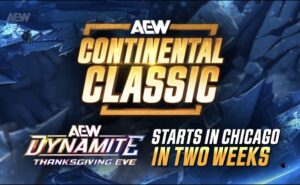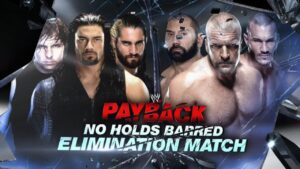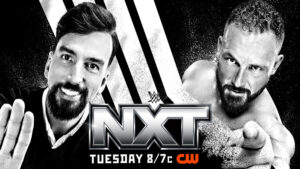Factions and gang warfare has been a tradition in New Japan for decades. Competing rival gangs, often lead by NJPW veterans became a simple and effective method of getting new stars over, introducing new gaijin wrestlers, and helping fill cards with territorial 6-man tag team matches, all within the construct of competing stables fighting for dominance in the turf known as New Japan Pro Wrestling. Some even point to the UWF “invasion” of NJPW in the late 80s as the first true gang war in New Japan, when former New Japan students who had previously legitimately quit NJPW to start a rival promotion, ended up coming back to invade their old stomping grounds. This entire angle is what apparently inspired a young Eric Bischoff when he created the New World Order in WCW in the mid-1990s, with WWF stars like Scott Hall (Razor Ramon), Kevin Nash (Diesel) and Hulk Hogan apparently doing a hostile takeover of WCW programming.
http://www.dailymotion.com/video/x60ilzd
It was 30 years ago today that another faction invaded New Japan, when on December 27, 1987, a famous Japanese comedian and movie/TV star Takeshi Kitano declared war on Antonio Inoki‘s New Japan at NJPW Year End in Kokugikan (Kitani may be best remembered by North American audiences for his 2003 cult film The Blind Swordsman: Zatōichi, or this year’s live action remake of Ghost in the Shell). Kitani proclaimed he was sick of what NJPW had become during the 1980s and no longer resembled the hard hitting Strong Style that made New Japan famous during its first decade of existence. Leading up to the event, Kitano proclaimed he was bringing in a big American wrestler to wipe out Inoki and had hired Japanese legend Masa Saito (a former 2x WWF Tag Team Champion with Mr. Fuji) to build him a stable of new recruits. Saito had “auditions” and chose recent NJPW Dojo graduates Gedo, Jado and Super Delfin, as well as enlisting his own tag partner and fellow veteran Riki Choshu. The American wrestler ended up being former AWA World Heavyweight Champion “Baby Bull Power” Leon White, a former NFL player with the Los Angeles Rams. In America, White was just another generic ex-football player – but in Japan, he became a Legend unto himself. White had initially travelled to Japan to work for New Japan’s rival promotion, All Japan Wrestling. But when previous attempts at signing Sid Vicious or the Ultimate Warrior failed, New Japan bought his contract from All Japan and decided to use White as the gaijin monster and focal point of Takeshi Puroresu Gundan, Kitano’s faction. The rest, they say, is history.

White was rebranded as Big Van Vader and put under a bizarre headdress that had its own pyrotechnics show, which covered another unique mask underneath. The whole faction was, in fact, a comedy spectacle (hence Kitano’s involvement), meant to parody the ‘Rock N’ Wrestling’ style that WWF was employing in the late 80s. But what happened during Takeshi Puroresu Gundan’s debut was anything but laughable. In fact it caused a financial disaster for New Japan that cost them their best venue for years. Following the night’s main event, which saw NJPW icon Antonio Inoki defeat Riki Choshu, Inoki called out Kitano’s US monster (according to Vader himself, he was unaware that he was supposed to fight that night and was drinking beer with the boys backstage when he heard Inoki call him out). And thus, Big Van Vader made his debut with NJPW.
https://www.youtube.com/watch?v=LZwGUsFm7_A
What resulted was one of the biggest shock moments in New Japan history. Vader not only came down and defeated Inoki, but did so in under 3 minutes. It was only Inoki’s second clean loss in over a decade (he’d lost by knockout to Hulk Hogan in the inaugural IWGP Tournament finals in 1983) and first by pinfall. And even his KO loss to Hogan in 1983 was at least a close 20+ minute affair. This new, relatively unknown American had just come in and destroyed Inoki in just 2 minutes and 49 seconds and became the first gaijin to hold the IWGP Heavyweight Championship (although two foreigners, Hulk Hogan and Andre the Giant, has previously won the IWGP Championship when it was simply an annual tournament). The New Japan fans saw absolutely zero humour in the humiliation of their beloved Inoki. So much so that an absolute riot took place in the infamous Sumo Hall, New Japan’s principle venue, and New Japan was banned from running shows there for two years.

New Japan would recover, but Takeshi Puroresu Gundan were short lived. While the fans loathed Vader for his first few appearances, the Mastadon would soon win over the Japanese crowds. Vader would end up becoming a 3x IWGP Heavyweight Champion during his 6-run in New Japan before beginning to work with WCW more predominantly in 1992. He’d been signed with WCW since 1990 (following the collapse of AWA), but only wrestled occasionally for them, due to his heavy schedule and popularity in Japan. But in 1992, he re-debuted with Harley Race as his manager and became a 3x WCW World Heavyweight Champion as well.

The other members of Takeshi Puroresu Gundan would have solid careers of their own. Riki Choshu would go on to become a 3x IWGP Heavyweight Champion himself in the early 90s, as well as a 3x IWGP Tag Team Champion, winner of the 1996 G1 Climax – he even booked New Japan in the late 90s. His last full time NJPW run ended in 2010, but he still wrestles in Japan, working limited appearances at various smaller promotions. Super Delfin headed to Frontier Martial-arts Wrestling (FMW) after Takeshi Puroresu Gundan folded and never really ever returned to NJPW as a full time regular (although he made occasional appearances). He headed to Mexico briefly after FMW, working with Universal Wrestling Association (UWA) and CMLL (he was a 2x CMLL Welterweight Champion), and when he came back home to Japan, worked long runs with Michinoku Pro, Osaka Pro, and Okinawa Pro (where he was a 4x Okinawa Pro Champion).

Gedo and Jado also headed to Mexico, but when they returned joined Wrestling Association-R (WAR) instead. Gedo initially paired up with “Lionheart” Chris Jericho, but by 1994 he and Jado would form a tag team and become of the top Junior Heavyweight Tag Teams of the 90s and 2000s – 5x WAR 6-Man Tag Team champs (with Hiromichi Fuyuki), WAR International Tag Team champs, 4x IWGP Junior Heavyweight Champs and last year they even captured Pro Wrestling NOAH‘s GHC Junior Heavyweight Champions. Although the pair didn’t return to NJPW until 2001, they made up for lost time. When Inoki lost control of NJPW and was forced out by new owners Yuke’s (the gaming company) in 2006, Gedo and Jado were handed the books and have been booking New Japan ever since.

So while Takeshi Puroresu Gundan started off as a joke that backfired miserably, it launched so very notable careers, including two 3x IWGP Champions and the very men responsible for the generation of New Japan that is leading us into Wrestle Kingdom 12 on January 4. Looks like Takeshi Kitano got the last laugh indeed.

Miss a day of #NewJapanWeek? You can catch up below!
-
12.22.2017: Preview: The History of NJPW
-
12.25.2017: Preview: Wrestle Kingdom 12 (1/4/2018)
-
12.26.2017: Tetsuya Naito: Stardust Champion to Ingobernable
-
12.27.2017: The Record Breaker: Kazuchika Okada
-
12.27.2017: Lionheart: Chris Jericho’s Return to Japan
-
12.27.2017: Takeshi Puroresu Gundan and The Last Laugh
-
12.28.2017: Switchblade: Jay White is NJPW’s Next Breakout Star
-
12.28.2017: Ace Under Pressure: Hiroshi Tanahashi
-
12.29.2017: Katsuya Kitamura: The Future of New Japan
-
12.29.2017: Kenny Omega: From Golden Love to Being The Elite
-
12.30.2017: Lion’s Gate: The Young Lions of NJPW
-
12.30.2017: Gang Warfare: Los Ingobernables de Japon
-
BONUS: Could Jericho vs. Naito Be Next on The List?






